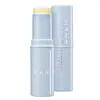What's inside
What's inside
 Key Ingredients
Key Ingredients

 Benefits
Benefits

 Concerns
Concerns

 Ingredients Side-by-side
Ingredients Side-by-side

Butylene Glycol Dicaprylate/Dicaprate
EmollientDimethicone
EmollientSilica
AbrasiveEthylhexyl Methoxycinnamate
UV AbsorberPolyethylene
AbrasiveButyloctyl Salicylate
Skin ConditioningVinyl Dimethicone/Methicone Silsesquioxane Crosspolymer
Diphenylsiloxy Phenyl Trimethicone
Skin ConditioningDicaprylyl Carbonate
EmollientEthylhexyl Salicylate
UV AbsorberCetyl Ethylhexanoate
EmollientTriethylhexanoin
MaskingParaffin
PerfumingDiethylamino Hydroxybenzoyl Hexyl Benzoate
UV FilterBis-Ethylhexyloxyphenol Methoxyphenyl Triazine
Skin ConditioningOctocrylene
UV AbsorberSorbitan Isostearate
EmulsifyingMicrocrystalline Wax
Emulsion StabilisingGlycyrrhiza Uralensis Extract
EmollientCaesalpinia Spinosa Fruit Extract
Skin ProtectingBacillus Ferment
Skin ConditioningCandida/Garcinia Cambogia Ferment
Kappaphycus Alvarezii Extract
Skin ConditioningOryza Sativa Germ Oil
EmollientSchisandra Chinensis Fruit Extract
Skin ConditioningHydrolyzed Collagen
EmollientLithospermum Erythrorhizon Root Extract
Skin ConditioningCurcuma Longa Root Extract
MaskingPhytosteryl/Isostearyl/Cetyl/Stearyl/Behenyl Dimer Dilinoleate
Skin ConditioningHydrogenated Polyisobutene
EmollientEthylhexyl Hydroxystearate
EmollientDisteardimonium Hectorite
StabilisingPropylene Carbonate
SolventCaprylyl Glycol
EmollientGlyceryl Caprylate
EmollientAdenosine
Skin ConditioningAluminum Hydroxide
EmollientTriethoxycaprylylsilane
Tocopherol
AntioxidantWater
Skin ConditioningButylene Glycol
Humectant1,2-Hexanediol
Skin ConditioningSoluble Proteoglycan
Skin ConditioningSodium Dna
Skin ConditioningParfum
MaskingButylparaben
MaskingHexyl Cinnamal
PerfumingBenzyl Salicylate
PerfumingHydroxycitronellal
PerfumingCitronellol
PerfumingAlpha-Isomethyl Ionone
PerfumingLinalool
PerfumingTitanium Dioxide
Cosmetic ColorantCI 77163
Cosmetic ColorantGardenia Florida Fruit Extract
Skin ConditioningButylene Glycol Dicaprylate/Dicaprate, Dimethicone, Silica, Ethylhexyl Methoxycinnamate, Polyethylene, Butyloctyl Salicylate, Vinyl Dimethicone/Methicone Silsesquioxane Crosspolymer, Diphenylsiloxy Phenyl Trimethicone, Dicaprylyl Carbonate, Ethylhexyl Salicylate, Cetyl Ethylhexanoate, Triethylhexanoin, Paraffin, Diethylamino Hydroxybenzoyl Hexyl Benzoate, Bis-Ethylhexyloxyphenol Methoxyphenyl Triazine, Octocrylene, Sorbitan Isostearate, Microcrystalline Wax, Glycyrrhiza Uralensis Extract, Caesalpinia Spinosa Fruit Extract, Bacillus Ferment, Candida/Garcinia Cambogia Ferment, Kappaphycus Alvarezii Extract, Oryza Sativa Germ Oil, Schisandra Chinensis Fruit Extract, Hydrolyzed Collagen, Lithospermum Erythrorhizon Root Extract, Curcuma Longa Root Extract, Phytosteryl/Isostearyl/Cetyl/Stearyl/Behenyl Dimer Dilinoleate, Hydrogenated Polyisobutene, Ethylhexyl Hydroxystearate, Disteardimonium Hectorite, Propylene Carbonate, Caprylyl Glycol, Glyceryl Caprylate, Adenosine, Aluminum Hydroxide, Triethoxycaprylylsilane, Tocopherol, Water, Butylene Glycol, 1,2-Hexanediol, Soluble Proteoglycan, Sodium Dna, Parfum, Butylparaben, Hexyl Cinnamal, Benzyl Salicylate, Hydroxycitronellal, Citronellol, Alpha-Isomethyl Ionone, Linalool, Titanium Dioxide, CI 77163, Gardenia Florida Fruit Extract
Water
Skin ConditioningDibutyl Adipate
EmollientPropanediol
SolventDiethylamino Hydroxybenzoyl Hexyl Benzoate
UV FilterPolymethylsilsesquioxane
Ethylhexyl Triazone
UV AbsorberNiacinamide
SmoothingMethylene Bis-Benzotriazolyl Tetramethylbutylphenol
UV FilterCoco-Caprylate/Caprate
EmollientCaprylyl Methicone
Skin ConditioningDiethylhexyl Butamido Triazone
UV AbsorberGlycerin
Humectant1,2-Hexanediol
Skin ConditioningButylene Glycol
HumectantBetula Platyphylla Japonica Juice
Skin ConditioningSodium Hyaluronate
HumectantHyaluronic Acid
HumectantGlyceryl Glucoside
HumectantDipotassium Glycyrrhizate
HumectantAllantoin
Skin ConditioningPortulaca Oleracea Extract
Skin ConditioningArtemisia Annua Extract
MaskingPinus Sylvestris Leaf Oil
MaskingAnthemis Nobilis Flower Oil
MaskingAcrylates/C10-30 Alkyl Acrylate Crosspolymer
Emulsion StabilisingSodium Stearoyl Glutamate
CleansingPolyacrylate Crosspolymer-6
Emulsion StabilisingEthylhexylglycerin
Skin ConditioningAscorbic Acid
AntioxidantAdenosine
Skin ConditioningPentylene Glycol
Skin ConditioningBehenyl Alcohol
EmollientPoly C10-30 Alkyl Acrylate
Emulsion StabilisingPolyglyceryl-3 Methylglucose Distearate
EmulsifyingDecyl Glucoside
CleansingTromethamine
BufferingXanthan Gum
EmulsifyingT-Butyl Alcohol
PerfumingTocopherol
AntioxidantCarbomer
Emulsion StabilisingWater, Dibutyl Adipate, Propanediol, Diethylamino Hydroxybenzoyl Hexyl Benzoate, Polymethylsilsesquioxane, Ethylhexyl Triazone, Niacinamide, Methylene Bis-Benzotriazolyl Tetramethylbutylphenol, Coco-Caprylate/Caprate, Caprylyl Methicone, Diethylhexyl Butamido Triazone, Glycerin, 1,2-Hexanediol, Butylene Glycol, Betula Platyphylla Japonica Juice, Sodium Hyaluronate, Hyaluronic Acid, Glyceryl Glucoside, Dipotassium Glycyrrhizate, Allantoin, Portulaca Oleracea Extract, Artemisia Annua Extract, Pinus Sylvestris Leaf Oil, Anthemis Nobilis Flower Oil, Acrylates/C10-30 Alkyl Acrylate Crosspolymer, Sodium Stearoyl Glutamate, Polyacrylate Crosspolymer-6, Ethylhexylglycerin, Ascorbic Acid, Adenosine, Pentylene Glycol, Behenyl Alcohol, Poly C10-30 Alkyl Acrylate, Polyglyceryl-3 Methylglucose Distearate, Decyl Glucoside, Tromethamine, Xanthan Gum, T-Butyl Alcohol, Tocopherol, Carbomer
 Reviews
Reviews

Ingredients Explained
These ingredients are found in both products.
Ingredients higher up in an ingredient list are typically present in a larger amount.
1,2-Hexanediol is a synthetic liquid and another multi-functional powerhouse.
It is a:
- Humectant, drawing moisture into the skin
- Emollient, helping to soften skin
- Solvent, dispersing and stabilizing formulas
- Preservative booster, enhancing the antimicrobial activity of other preservatives
Adenosine is in every living organism. It is one of four components in nucleic acids that helps store our DNA.
Adenosine has many benefits when used. These benefits include hydrating the skin, smoothing skin, and reducing wrinkles. Once applied, adenosine increases collagen production. It also helps with improving firmness and tissue repair.
Studies have found adenosine may also help with wound healing.
In skincare products, Adenosine is usually derived from yeast.
Learn more about AdenosineButylene Glycol (or BG) is used within cosmetic products for a few different reasons:
Overall, Butylene Glycol is a safe and well-rounded ingredient that works well with other ingredients.
Though this ingredient works well with most skin types, some people with sensitive skin may experience a reaction such as allergic rashes, closed comedones, or itchiness.
Learn more about Butylene GlycolDiethylamino Hydroxybenzoyl Hexyl Benzoate (DHHB) is a chemical UV-A absorber. It is formulated for high UVA protection (320-400 nm).
DHHB is well-liked for:
DHHB has been approved by the EU, Japan, Taiwan, and South America for use up to 10%. Unfortunately, it has not been approved for use in the US or Canada due to slow regulatory processes.
This ingredient is soluble in oils, fats, and lipids.
Learn more about Diethylamino Hydroxybenzoyl Hexyl BenzoateTocopherol (also known as Vitamin E) is a common antioxidant used to help protect the skin from free-radicals and strengthen the skin barrier. It's also fat soluble - this means our skin is great at absorbing it.
Vitamin E also helps keep your natural skin lipids healthy. Your lipid skin barrier naturally consists of lipids, ceramides, and fatty acids. Vitamin E offers extra protection for your skin’s lipid barrier, keeping your skin healthy and nourished.
Another benefit is a bit of UV protection. Vitamin E helps reduce the damage caused by UVB rays. (It should not replace your sunscreen). Combining it with Vitamin C can decrease sunburned cells and hyperpigmentation after UV exposure.
You might have noticed Vitamin E + C often paired together. This is because it is great at stabilizing Vitamin C. Using the two together helps increase the effectiveness of both ingredients.
There are often claims that Vitamin E can reduce/prevent scarring, but these claims haven't been confirmed by scientific research.
Learn more about TocopherolWater. It's the most common cosmetic ingredient of all. You'll usually see it at the top of ingredient lists, meaning that it makes up the largest part of the product.
So why is it so popular? Water most often acts as a solvent - this means that it helps dissolve other ingredients into the formulation.
You'll also recognize water as that liquid we all need to stay alive. If you see this, drink a glass of water. Stay hydrated!
Learn more about Water